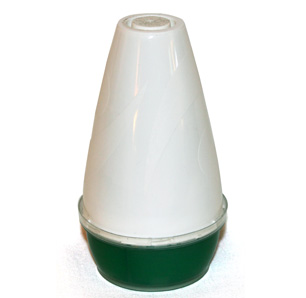Dichlorobenzenes (DCBs)
| EPA Maximum Contaminant Level (MCL) |
1,4-DCB | 0.075 mg/L |
| 1,2-DCB | 0.6 mg/L |

1,4-Dichlorobenzene can be found in some air fresheners.
Dichlorobenzenes (1,2-Dichlorobenzene, 1,3-Dichlorobenzene and 1,4-Dichlorobenzene, also known as DCBs) are chemicals used in a wide range of industrial and domestic products. Their primary uses are in odor masking chemicals, dyes and pesticides, but they're also used in herbicides, waxes, gums, resins, wood preservatives, paints, coolants, degreasers and pharmaceuticals.
Human exposure to DCBs may occur through foods (especially milk or fish, where they accumulate in fatty tissue) or contaminated water. They have been detected in ground water, surface-water and drinking-water in the United States.
Health Effects of DCBs
DCBs have a low toxicity with acute exposure. The World Health Organization lists anemia, respiratory irritation, glomerulonephritis (kidney damage), and allergic skin reactions as symptoms.
Long term exposure can lead to harmful effects on the blood, circulatory system, central nervous system, gastrointestinal system, spleen and liver. Evidence from animal studies suggests that dichlorobenzenes may be carcinogenic. The International Agency for Research on Cancer and EPA classify 1,4-dichlorobenzene as being a “possible human carcinogen.”
Water Treatment for DCBs
The EPA recommends granular activated carbon (GAC) and packed tower aeration (an air stripping method.) According to Lenntech, activated carbon has a “very high probability” of adsorbing dichlorobenzenes.
Sources: EPA (1), EPA (2), EPA (3), EPA (4), WHO, Lenntech, Photo: WikiMedia, author: Dwight Burdette
Site Index
Filtration Systems
- Aeration for Iron & Sulfide
- Backwashing Filters
(whole house & well units)
- Chlorine & Chemical Injectors
- Countertop Water Filters
- Emergency Filters
- Garden Hose Filters
- Reverse Osmosis, Residential
- Reverse Osmosis, Commercial
- Shower Filters
- Specialty Filters
- Ultraviolet Systems
- Undersink Filters
- Water Softeners
- Whole House Filters
Cartridges
Parts
- Replacement Parts
- Faucets
- Filter Media
- Fittings
- Housings
- O-rings
- Pumps
- Pura UV
- R.O. Parts
- R.O. Tanks
- R.O. Booster Pump
- VIQUA UV